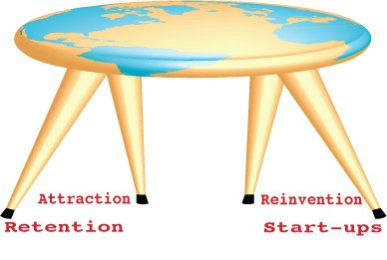In analyzing the BDS report, Tim Kane, senior fellow in Research and Policy at the Ewing Marion Kauffman Foundation, comments: "States and cities with job creation policies aimed at luring larger, older employers can't help but fail.because they are not based on realistic models of employment growth. Job growth is driven, essentially entirely, by startup firms that develop organically."
Historically, this is nothing new - most new jobs have always been created by small business. However, during a time when new job creation is a headline event, economic development agencies are well focused on these statistics. As a result, marketing efforts, incentive approaches, and broad strategies are being developed to attract and organically grow these new enterprises and "win" these new jobs. This is an admirable effort on the part of those agencies; however, when this approach is taken at the expense of other tried and true attraction and retention programs, the state and local communities involved will be negatively impacted as a result - and run the risk of turning their backs on new jobs associated with more "traditional" industry.
Recent Experiences Are Tell-Tale
Using two actual project experiences as an illustration of current economic development agency attitudes will shed light on the current dynamic in policy application:
- Example 1: The location consulting assignment involved over $100 million in capital investment and 1,500 new distribution-oriented jobs. Multiple states/communities, although somewhat responsive in attempting to "close" the sale, did not consider this potential project a high priority and were unwilling to consider monetary incentives and assistance beyond the minimal level because the jobs being created paid minimum wage.
- Example 2: The subject employer was an embryonic high-tech video game creator projecting approximately 150 new jobs with minimal capital investment. This project piqued a very high level of economic development agency interest and response - and was provided exceptional incentive value. This high-tech organization clearly captured the attention of many communities based on their desire to gain bragging rights for capturing a sought after "new economy" employer.
Historically, a fundamental responsibility of economic development leadership is to set direction and create strategy and policy for its community's long-term ambition. Certainly every community - either on a local, regional, or state level - aspires to a higher level as measured by average wage or other metrics. However, it is also the responsibility of leadership to stabilize the short-term necessities. Economic development is indeed a difficult balancing act that requires a balanced portfolio of incentives and goals.
A 4th Leg on the Economic Development Stool
Traditional economic development efforts - whether public, private, or a hybrid - maintain resources focused on three categories of new job creation, i.e., "the three legs of the stool." These include attraction efforts (luring new employers to an area), retention efforts (keeping employers in the area and assisting them to grow), and reinvention efforts (providing assistance to employers undergoing change - think Bell Labs, Kodak, Polaroid).
During the past decade, job creation has been strongly linked to innovation - including either high-technology industries or the highly discussed new entrepreneurial enterprises. This trend has brought about an economic development effort focused on start-ups (focused on growing your own), the "fourth leg" of the economic development stool. This approach clearly recognizes the need to cater to small businesses, which after all, are the largest creators of new jobs, and also incorporates the need to embrace a new culture in attracting and assisting the modern-day entrepreneur.




